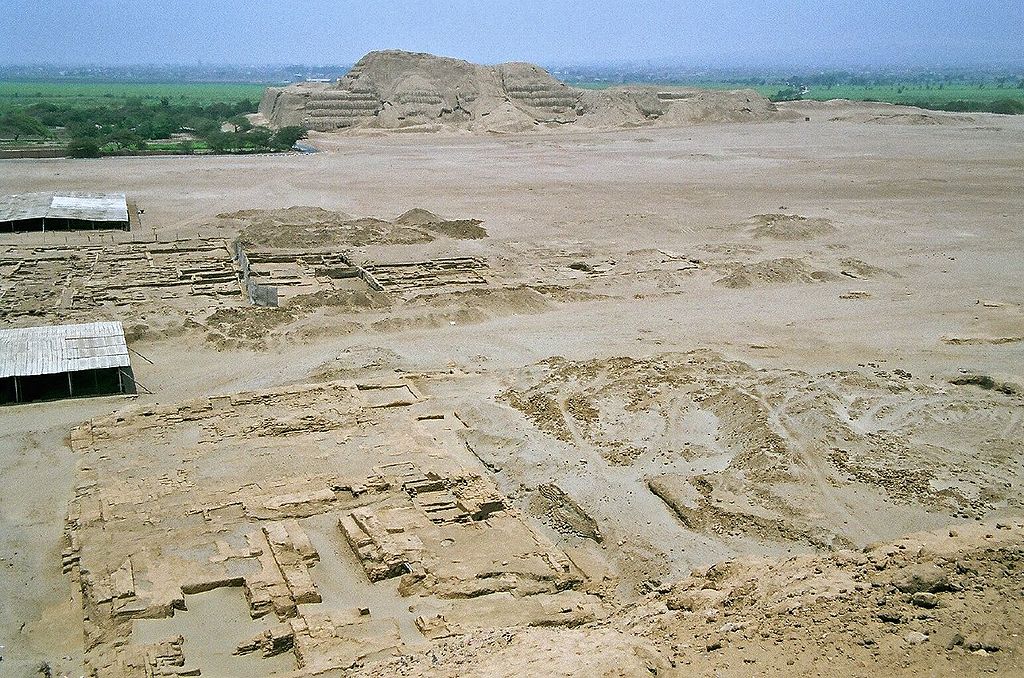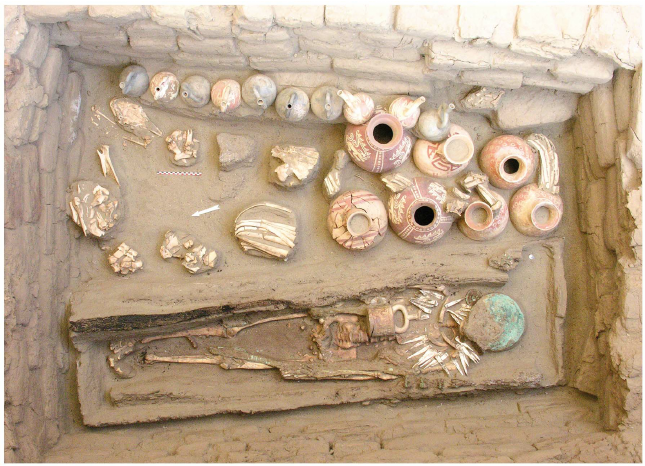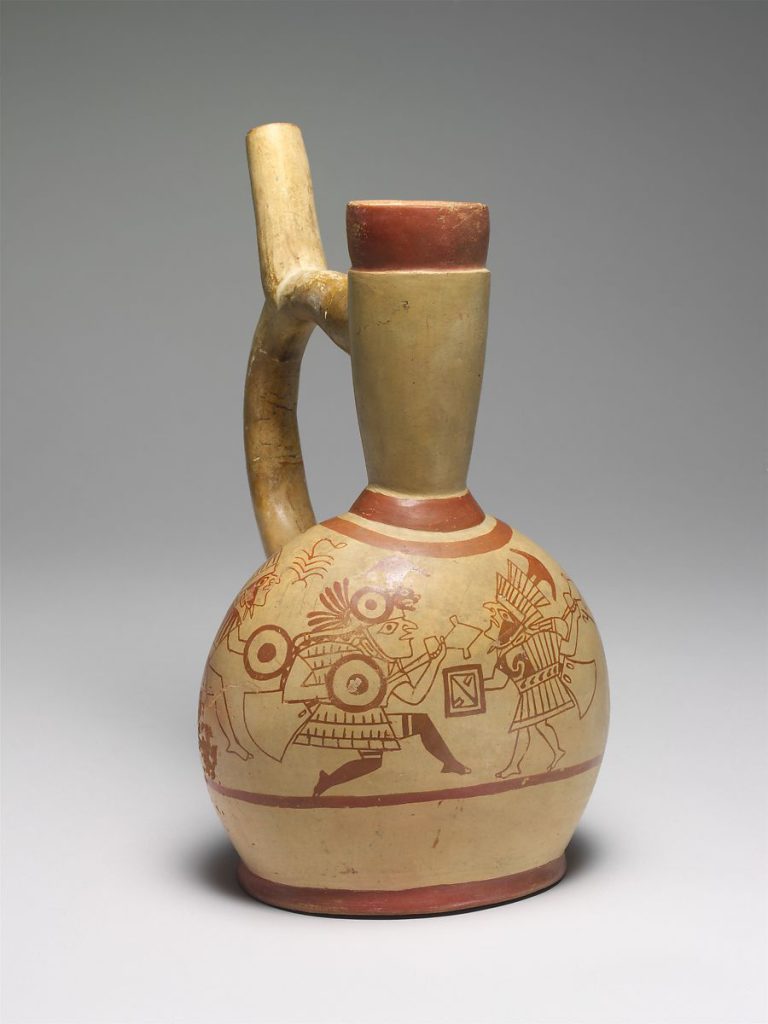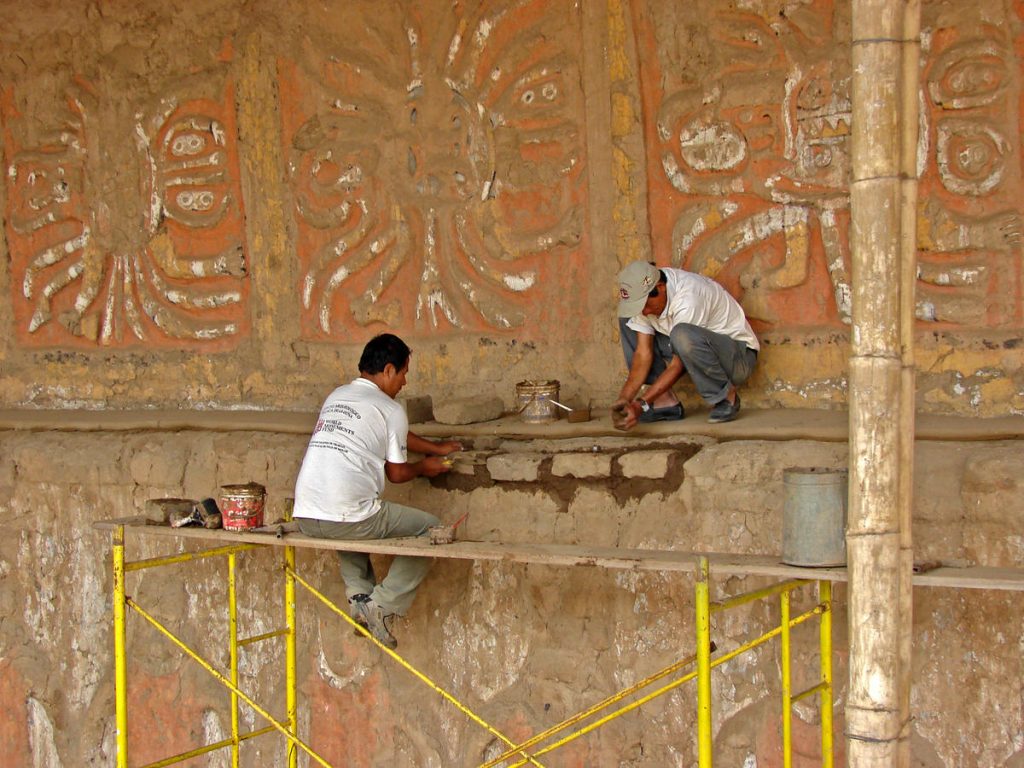អរិយធម៌ម៉ូច (Moche )ឬហៅម្យ៉ាងទៀតថា ម៉ូឈីកា (Mochica) គឺជាអរិយធម៌ចាស់មួយដែលស្ថិតនៅក្នុងតំបន់អាមេរិកខាងត្បូង ដែលសព្វថ្ងៃជាតំបន់ខាងជើងនៃប្រទេសប៉េរូ (Peru)។ ចំពោះឈ្មោះ ម៉ូចនេះគឺហៅតាមទន្លេ ម៉ូច (Moche river) ដែលជាទន្លេស្ថិតនៅក្បែរតំបន់នោះ ហើយដែលជាទន្លេធំជាងគេក្នុងតំបន់ដែរ។ អរិយធម៌នេះមានការរីកចម្រើននៅចាប់ពីស.វ.ទី១នៃគ.ស. រហូតដល់ស.វ.ទី៨នៃគ.ស. ដែលស្ថិតនៅខាងលិចនៃជ្រលងភ្នំ អេនឌៀន។ តាមរយៈស្លាកស្នាមក្រុងបុរាណ និងសំណង់ស្ថាបត្យកម្មផ្សេងៗ អ្នកស្រាវជ្រាវបានបង្ហាញថារាជធានីនៃអរិយធម៌នេះស្ថិតនៅក្បែរនឹងទីក្រុង Trujillo (ទ្រូជីឡូ) ដែលមានចម្ងាយប្រមាណជាង១៨០ ម៉ែត្រពីរាជធានីលីម៉ានៃប្រទេសប៉េរូ។
ក្រុងនៃអរិយធម៌នេះ មានទីតាំងស្ថិតនៅក្បែរនឹងក្រុងទ្រូជីឡូប្រមាណ៤គីឡូ និងក្បែរសមុទ្រប៉ាស៊ីហ្វិក ៥គីឡូម៉ែត្រ សំណង់ប្រាសាទចំនួន២ត្រូវបានគេស្គាល់ជាសំណង់ស្ថាបត្យកម្មដ៏សំខាន់នៅក្នុងអរិយធម៌ម៉ូច។ តាមរយៈស្លាកស្នាមទាំងនោះ អ្នកស្រាវជ្រាវបានបង្ហាញថា ការរៀបចំក្រុងម៉ូច គឺជាការរៀបចំជាបណ្តុំនៃសំណង់សាសនា (Complex monuments) ដែលសំណង់គោលនោះ គឺជាប្រាសាទពីរ៉ាមីត ប្រាសាទ Huaca de la Luna ឬ ប្រាសាទនៃព្រះច័ន្ទ និង Huaca del Sol ឬប្រាសាទនៃព្រះអាទិត្យ ដែលមិនខុសអ្វីពីអរិយធម៌មុនៗនោះទេ។
ផ្នែកខាងមុខនៃសំណង់ប្រាសាទនៃព្រះអាទិត្យត្រូវបានបំផ្លាញជីកដោយពួកអេស្ប៉ាញនៅអំឡុងស.វ.ទី១៦ ដើម្បីធ្វើជាព្រែកជីកក្នុងការដឹកជញ្ជូនទំនិញផ្សេងៗទៅកាន់សមុទ្រប៉ាស៊ីហ្វិក។ លក្ខណៈពិសេសនៃសំណង់ស្ថាបត្យកម្មនៃប្រាសាទទាំងពីរនោះ គឺជាចម្លាក់ក្រឡោតទាប និងរូបគំនូរទឹកពណ៌ នៅលើតាមជញ្ជាំងប្រាសាទដែលជាស្នាដៃគំនូរដ៏អស្ចារ្យ នេះក៏អាចនិយាយបានថាមនុស្សក្នុងអរិយធម៌នេះមានបច្ចេកទេសខ្ពស់ ក្នុងការឆ្លាក់ដែលអាចរក្សាបានយូររហូតដល់សព្វថ្ងៃនេះ។
ចាប់តាំងពីការរកឃើញផ្នែកសំខាន់ៗនៃសំណង់ប្រាសាទពីរនេះមក មានអ្នកស្រាវជ្រាវជាច្រើន ទាំងអ្នកស្រាវជ្រាវជនជាតិប៉េរូ និងអន្តរជាតិបានសិក្សាទីតាំងជាច្រើននៅស្ថានីយនេះ។ ឧទាហរណ៍ លោក M. Uhle បុរាណវិទូជនជាតិអាឡើម៉ង់ បានធ្វើការងារកំណាយនៅទីតាំងស្ថានីយបុរាណនៃអរិយធម៌ម៉ូចនេះដំបូងគេ ក្នុងអំឡុងចុងស.វ.ទី១៩ ពោលគឺនៅឆ្នាំ ១៨៩៩ ដែលលោកបានធ្វើកំណាយនៅទីតាំងប្រាសាទទាំងពីរដោយបានរកឃើញនូវផ្នូរសពដែលជាកប់សពមនុស្សស្រី ដែលប្រហែលជាស្លាប់ដោយការបូជាយាញ្ញ (Cemetery of sacrificed women) កុលាភាជន៍ និងវត្ថុសិល្បៈជាច្រើនទៀត (រូបលេខ៤)។ នៅអំឡុងឆ្នាំ ២០០២-២០០៦ អ្នកស្រាវជ្រាវជនជាតិបារាំងបានទៅធ្វើកំណាយរកឃើញផ្នូរសពសរុប៥៣ផ្នូរ និងរួមផ្សំនឹងវត្ថុសំណែនផ្សេងៗរួមមានកុលាលភាជន៍ និងគ្រឿងអាលង្កាផ្សេងៗជាដើម។ តាមរយៈការសិក្សាលើធ្មេញនៃគ្រោងឆ្អឹងទាំងនោះ បានបង្ហាញថា ជាមនុស្សប្រុស និងស្រីវ័យជំទង៕
យោងការរកឃើញវត្ថុសិល្បៈជាច្រើន អ្នកស្រាវជ្រាវបានបង្ហាញថាប្រជាជនក្នុងអរិយធម៌នេះមានជំនាញក្នុងការផលិតវត្ថុសិល្បៈ តាមទម្រង់ផ្សេងៗដែលបានរកឃើញពីកន្លែងជាច្រើននៃអរិយធម៌នេះរួមមាន គ្រឿងស្មូនដី គ្រឿងអលង្ការ រូបចម្លាក់ដី អំពីថ្ម លោហៈធាតុ។ សិល្បៈ និងសំណង់ស្ថាបត្យកម្មទាំងនោះ គឺជាសិល្បៈដែលមានទម្រង់ប្លែក តែមានបច្ចេកទេសខ្ពស់ ក្នុងការគូរគំនូរទាំងនៅលើជញ្ជាំងប្រាសាទ និងរូបគំនូរលើកុលាលភាជន៍ជាដើម។ ការសិក្សាលើរូបគំនូរនៅលើកុលាល-ភាជន៍ទាំងនោះបានបង្ហាញពីសង្គម និងមជ្ឈដ្ឋានជុំវិញនៃអរិយធម៌នេះកាលពីសម័យបុរាណ។ លើសពីនេះ អ្នកស្រាវជ្រាវពុំបានដឹងអំពីមូលហេតុច្បាស់លាស់នៃការដួលរលំនៃអរិយធម៌ម៉ូចនេះនៅឡើយទេ ប៉ុន្តែប្រហែលមកពីការប្រែប្រួលអាកាសធាតុក្នុងតំបន់ ឬប្រហែលមកពីកត្តាសង្គមក្នុងអរិយធម៌នេះផ្ទាល់។
តាមរយៈការបង្ហាញទិន្ន័យទាំងឡាយមក ជាពិសេសទិន្ន័យនៃការរកឃើញផ្នូរសពបានឱ្យយើងអាចដឹងអំពីទំនៀមទន្លាប់នៃការកប់សព ដែលមនុស្សសម័យបុរាណប្រតិបត្តិ ហើយក៏អាចដឹងពីទិដ្ឋភាពសង្គមនោះបាន តាមរយៈគំនូររូបលើកុលាលភាជន៍ដែលកប់ជាមួយនឹងផ្នូរសព៕
—————————————————–
Moche civilization
The Moche civilization, also known as the Mochica, is an ancient civilization located in South America, now northern Peru. The name Moche is derived from the Moche River, which is a river nearby this area and also is the largest river in the area. This civilization flourished from the first century until the 8th century located west of the Andean Valley. According to archaeological evidence and other architectural structures, researchers indicate that the capital of this civilization was located near Trujillo city, more than 180 meters from the Lima capital of Peru.
This city of this civilization is located about 4 km from Trujillo and 5 km from the Pacific Ocean. Two temples are known as important architectural structures in the Moche civilization. Based on the traces, researchers have shown that Moche is the complex monument of religion, the main ones being the pyramids of Huaca de la Luna or the temple of the moon and Huaca del Sol or the temple of the sun, which are no different from previous civilizations. The architectural features of the two temples are the bas-relief and the watercolor paintings on the wall of this temple, which are magnificent paintings. It might be people in this civilization have a high level of carving techniques that can be preserved for a long time until today. Since the discovery of the main parts of the two temple structures, many Peruvian and international researchers have studied the site. For instance, the German archaeologist M. Uhle first excavated the site of the ancient site of the Moche civilization during the late 19th century, in 1899 when he excavated the two temples and found the graves of women who may have died by the cemetery of sacrificed, ceramics and other artifacts. During 2002-2006, French researchers excavated a total of 53 graves and combined item worships, including ceramics and other jewelry. Based on the studies of the teeth of these skeletons have shown that they are male and female adolescents.
Through the discovery of many artifacts, researchers have shown that people in this civilization are skilled in the production of artifacts in various forms found in many places of this civilization, including ceramics, jewelry, sculptures made from earthen, stone, and metal.
Art and architecture are art forms that are unique but highly technical in paintings on temple walls and on ceramics. The study of the paintings on the ceramic reveals the society and environment of this ancient civilization. In addition, researchers do not yet know the exact cause of the collapse of the Mole civilization, but perhaps due to local climate change or perhaps due to social factors in this civilization itself.
Based on the indication of data above, especially the data of the discovery of graves, thus we can know about the burial traditions that ancient people practiced and also know about that social aspect through the paintings on the ceramics that were buried with the grave.
អត្ថបទដើម៖ លោក អេង តុលា













